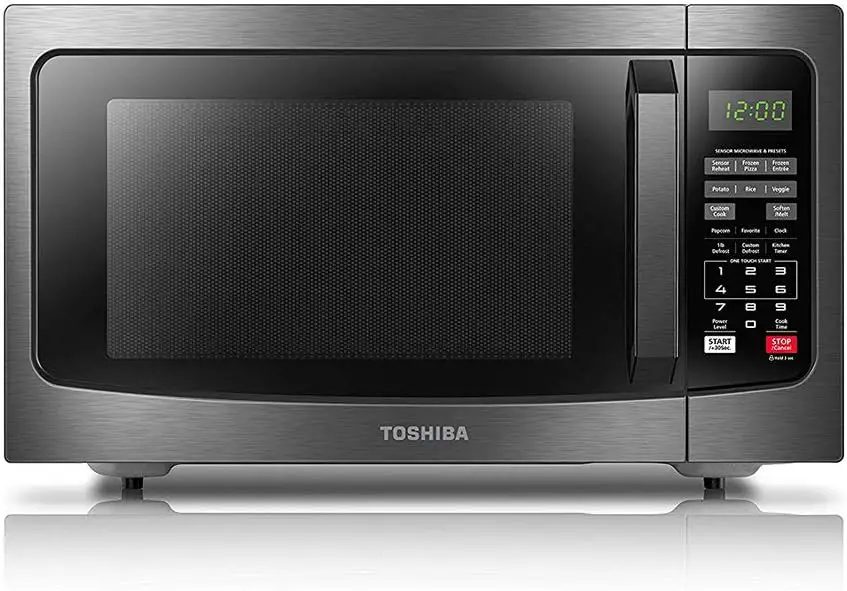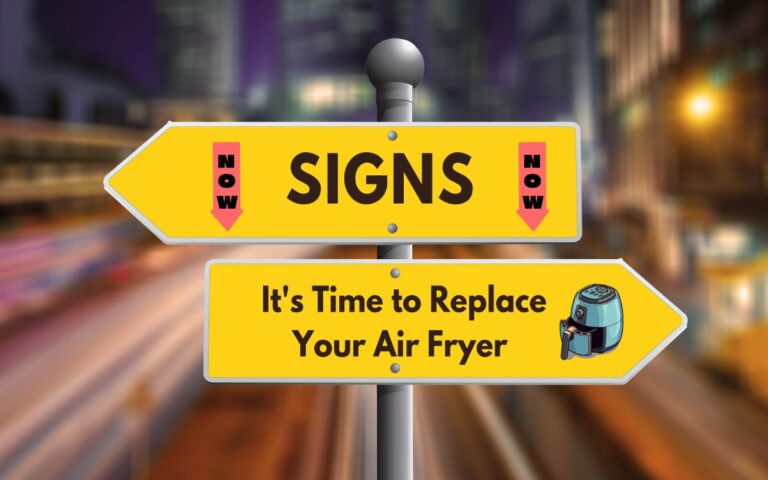Can An Air Fryer Replace a Microwave?
Kitchen appliances simplify our lives.
An example of two appliances found in almost every kitchen are the microwave and the air fryer.
While the microwave has been a kitchen staple for decades, the air fryer is relatively new.
Each has its unique features and functions, but can an air fryer truly replace a microwave?
In this article, we will explore the capabilities of both appliances and help you decide if you can make the switch from a microwave to an air fryer.
Understanding Air Fryers and Microwaves
Before we can determine whether an air fryer can replace a microwave, let’s take a closer look at each appliance’s fundamental workings.
· Air Fryers
Air fryers are countertop convection ovens that use hot air circulation to cook food.
They’re equipped with a fan that distributes hot air evenly around the food, creating a crispy outer layer.
Air fryers are known for their ability to mimic the results of deep frying but with significantly less oil, making them a healthier option.
· Microwaves
Microwaves use electromagnetic waves to heat and cook food.
They work by exciting water molecules in the food, generating heat.
Microwaves are best known for their speed and convenience in reheating leftovers, defrosting frozen items, and cooking certain dishes quickly.
Can An Air Fryer Replace a Microwave?
An air fryer and a microwave serve different purposes in the kitchen.
They cannot fully replace each other, as they excel at different types of cooking.
While an air fryer can handle some tasks performed by a microwave, like reheating foods, it cannot replace a microwave entirely due to its limited cooking methods.
Both appliances have their unique functions, and it’s best to have both in your kitchen to cover a wider range of cooking and reheating needs.
The Role of Air Fryers vs. Microwaves in Daily Life
Both air fryers and microwaves have their roles in daily life.
The different aspects are summarized below:
| Aspect | Air Fryers | Microwaves |
| Cooking Method | Uses hot air circulation to cook food with a small amount of oil or none | Uses electromagnetic waves to heat and cook food rapidly |
| Cooking Speed | Slower than microwaves for some items, but faster than traditional ovens. | Faster cooking times for reheating, cooking, and defrosting |
| Cooking Versatility | Suitable for frying, baking, roasting, and grilling | Primarily used for reheating, defrosting, and some basic cooking |
| Healthier Cooking | Offers a healthier cooking option by using less oil and reducing fat content | Does not inherently promote healthier cooking but is versatile for various food types |
| Food Texture | Achieves a crispy texture on foods without deep frying | Maintains moisture in some dishes but may not crisp them up like an air fryer |
| Food Reheating | May require more time for reheating, but provides a crisper result | Quick and efficient for reheating leftovers and retaining some texture |
| Cooking Capacity | Have smaller cooking capacities compared to microwaves | Offer larger cooking spaces for larger dishes or containers |
| Energy Efficiency | More energy-efficient for cooking small batches of food | Efficient for reheating and quick cooking tasks, but not as efficient for large dishes |
| Food Types | Suitable for a wide range of foods like frozen snacks, chicken wings, and vegetables | Best for reheating leftovers, and beverages, and cooking some pre-packaged microwaveable meals |
| Maintenance | Requires regular cleaning, especially of the air frying basket or tray | Easy to clean with removable turntable and glass turntable plate |
| Cost | More options to consider in terms of price compared to microwaves | Basic models of microwaves are more expensive compared to air fryers |
| Kitchen Space | Takes up counter space and can be bulkier | Compact and easily fits on countertops or can be built into cabinets |
| Cooking Noise | Produces noise due to the fan and air circulation | Operates quietly with minimal noise during cooking |
| Cooking Experience | Offers a unique cooking experience with healthier results and versatile cooking options | Provides convenient and quick heating, suitable for busy lifestyles |
Air Fryers vs. Microwaves: How They Differ
1. Cooking Mechanisms
The key difference between air fryers and microwaves is their cooking mechanism.
Air fryers rely on convection cooking, where hot air is constantly circulated the food.
Air fryers are excellent for cooking French fries, chicken wings, other meats, and even vegetables, giving them a delightful crunch without excessive oiliness.
Microwaves use microwave radiation to heat food. This method is exceptionally fast and convenient for reheating and defrosting.
They don’t excel at crisping or browning food.
They are better suited for tasks like heating foods and liquids, melting butter, or quickly cooking certain dishes.
2. Speed and Efficiency
When it comes to speed and efficiency, both appliances have their strengths and weaknesses.
Air fryers are not as quick as microwaves when it comes to reheating or cooking certain items.
The preheating process and the convection cooking method can take a bit longer.
Microwaves are known for their speed.
With the push of a button, you can heat leftovers or defrost frozen items in a matter of minutes.
This makes them a valuable tool for busy individuals who need a quick meal or snack.
3. Versatility and Cooking Options
Air fryers are incredibly versatile and can be used for a wide range of cooking tasks.
Apart from frying, they can bake, roast, grill, and even dehydrate.
This versatility makes them suitable for preparing a variety of dishes, from crispy chicken to roasted vegetables.
Microwaves are less versatile in terms of cooking options.
They excel at reheating and defrosting but have limited capabilities when it comes to cooking different types of food.
While you can use a microwave to steam vegetables or cook certain microwave-safe meals, it doesn’t provide the same range of cooking options as an air fryer.
4. Food Quality and Taste
The quality and taste of the food prepared in these appliances are significant considerations.
Air fryers often produce foods with a crispy exterior and a tender interior.
Microwaves may not always deliver the best quality in terms of texture.
Foods reheated in a microwave can become too dry, or even soggy and rubbery, which is less desirable for certain dishes.
5. Health Considerations
Air fryers are often considered a healthier cooking option because they use significantly less oil compared to deep frying.
Check out our comparison between an air fryer and a deep fryer.
You can enjoy crispy favorites with fewer calories and less fat.
Microwaves don’t add or remove nutrients from food, but the way they cook can impact the nutritional content.
Overcooking in a microwave can lead to nutrient loss, so it’s essential to use proper cooking times and methods.
Microwaves are often neutral when considering the health impact.
6. Energy Efficiency
Energy efficiency is another factor to consider, especially if you’re concerned about your utility bills.
Air fryers are relatively energy-efficient as their cooking technology allows for the cooking of food without the need for a lot of energy.
The shorter cooking times for certain dishes also contribute to their energy efficiency.
Microwaves work by generating microwave radiation that excites water molecules within the food, generating heat.
While this process is fast, it’s not the most efficient way to convert energy into heat.
Some energy is lost in the form of electromagnetic radiation.
7. Kitchen Space
The size and placement of these appliances in your kitchen can impact your cooking experience.
Air fryers come in various sizes, but even larger models are generally compact and fit well on countertops.
They don’t take up as much space making them suitable for smaller kitchens.
Microwaves are available in different sizes as well.
However, they often require designated counter space or built-in installation.
8. Cost Comparison
Air fryers come in a wide price range, from affordable models to high-end options with advanced features.
The cost of an air fryer will depend on its size, brand, and functionality.
You can find an air fryer that costs between $35 and $350.
Microwaves are more expensive when compared to air fryers.
Basic models are available from $75, those with more advanced features costing $150+, and built-ins going for $1,000 and above.
9. Simplicity
Microwaves are incredibly easy to use, making them a popular choice for people of all ages.
You simply place your food inside, set the timer, and press start. There’s no need for extensive cooking knowledge.
Air fryers, although versatile, may require a bit more expertise to achieve the desired results.
Air Fryer vs. Microwave: Making the Decision
So, can an air fryer replace a microwave? The answer depends on your specific needs and cooking preferences.
If you value versatility, enjoy cooking a wide range of dishes, and are health-conscious, an air fryer could be a great addition to your kitchen.
It can replace your microwave for reheating purposes while offering numerous other cooking options.
However, if speed and simplicity are your top priorities, the microwave remains an indispensable appliance.
It’s hard to beat the convenience of quickly heating leftovers or preparing a bag of microwave popcorn.
Conclusion
Both the air fryer and the microwave have their merits and limitations.
Rather than replacing one with the other, consider having both appliances in your kitchen.
This way, you can enjoy the benefits of quick heating and versatile cooking, ensuring that your needs are met, no matter the occasion.
You can also opt for a hybrid.
There are plenty of air fryer oven combos that incorporate the best features of both the microwave and the air fryer.
- Air Fryer Chicken Parmesan Recipes - September 17, 2024
- Air Fryer Sweet Potato Fries Recipes - August 8, 2024
- Air Fryer Seasoning Mistakes You’re Making - July 22, 2024









